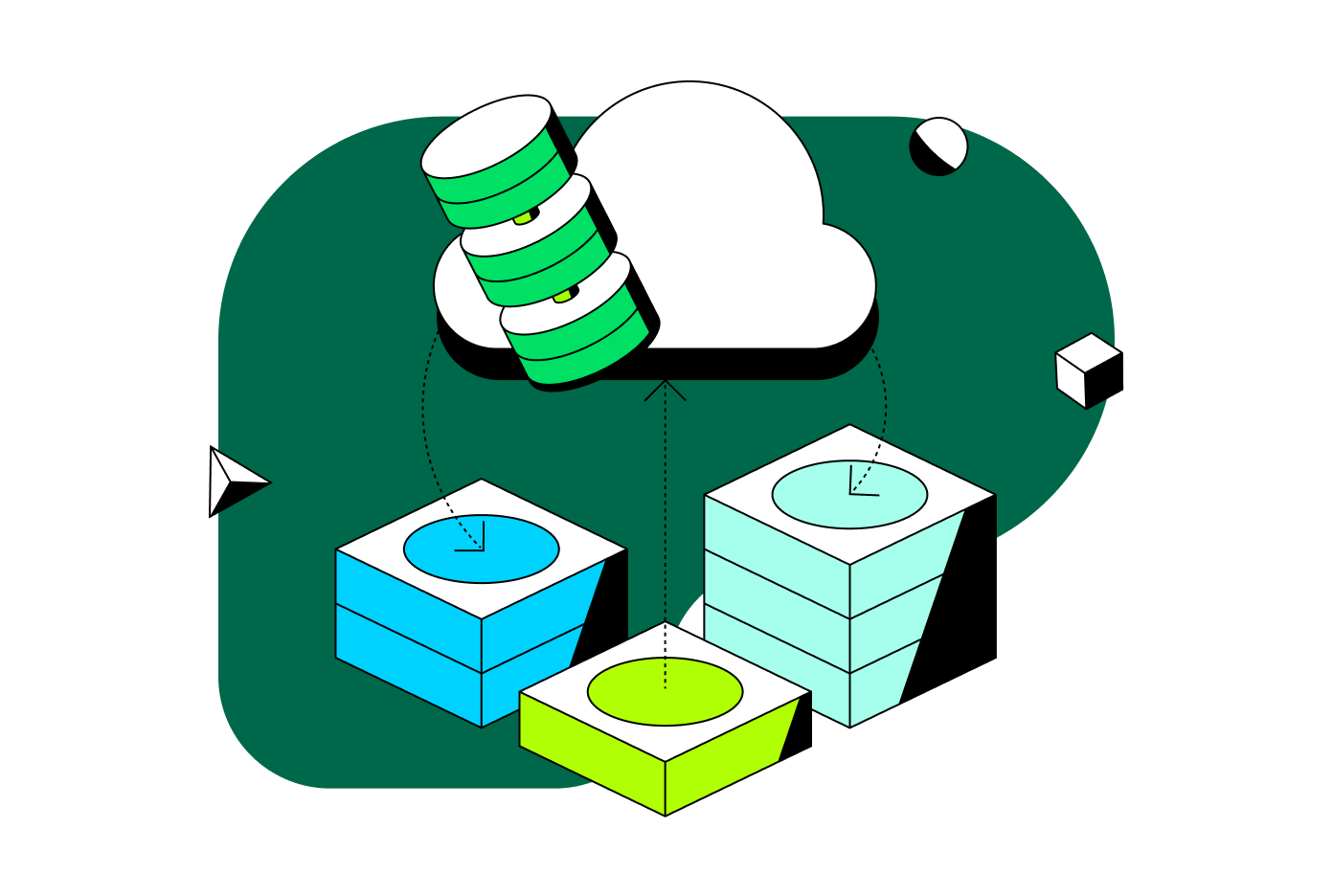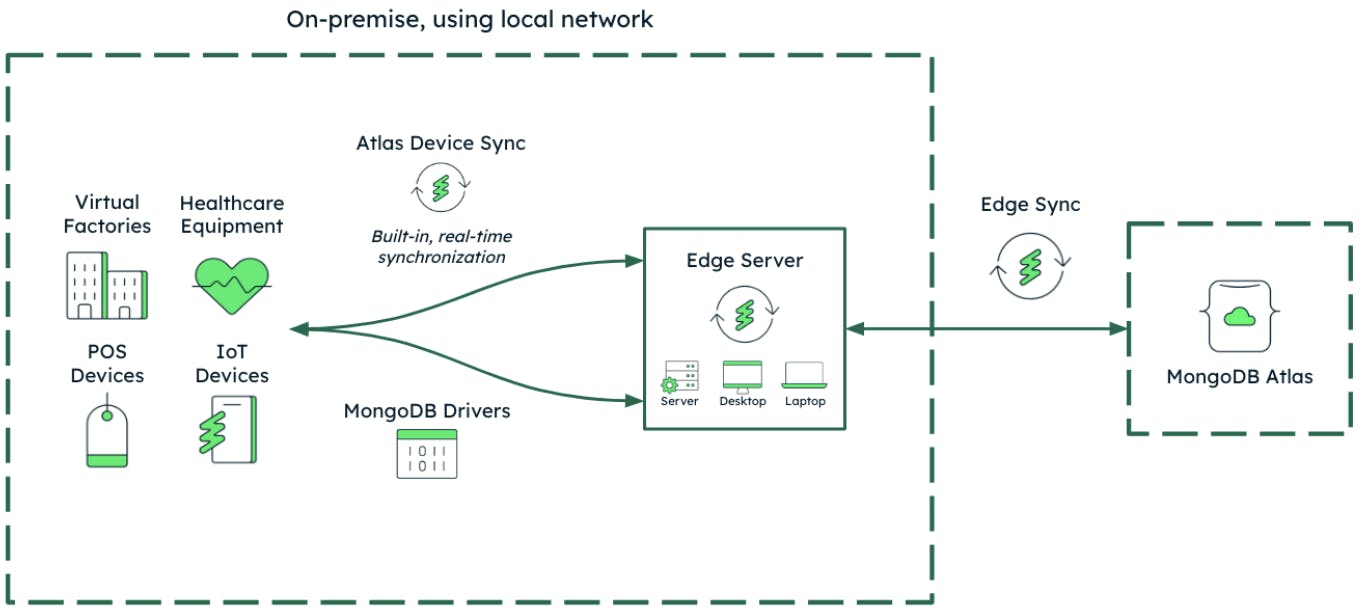Introducing Atlas for the Edge
September 26, 2023 | Updated: November 27, 2025
>> Announcement: Some features mentioned below will be deprecated on Sep. 30, 2025. Learn more.
Update May 2, 2024: Atlas Edge Server is now in public preview. Check out our blog to learn more.

We are thrilled to introduce MongoDB Atlas for the Edge at MongoDB.local London. This new solution is designed to streamline the management of data generated across various sources at the edge, including devices, on-premises data centers, and the cloud.
Edge computing, which brings data processing closer to end-users, offers significant advantages. At the same time, it often proves challenging due to complex networking, data volume management, and security concerns, which can deter many organizations. They are also costly to build, maintain, and scale. Some challenges organizations face include:
-
Significant technical expertise to manage the complexity of networking and high volumes of distributed data required to deliver reliable applications that run anywhere
-
Stitching together hardware and software solutions from multiple vendors, resulting in complex and fragile systems that are often built using legacy technology that is limited by one-way data movement and requires specialized skills to manage and operate
-
Constant optimization of edge devices due to their constraints — like limited data storage and intermittent network access — which makes keeping operational data in sync between edge locations and the cloud difficult
-
Security vulnerabilities and frequent firmware patches and updates to ensure data privacy and compliance
MongoDB Atlas for the Edge simplifies all of these manual tasks. It allows MongoDB to run on diverse edge infrastructure, from self-managed, on-premises servers to cloud deployments offered by major cloud providers. Data seamlessly flows between and is kept synchronized across all sources, ensuring real-time data delivery with minimal latency.
With MongoDB Atlas for the Edge, organizations can now use a single, unified interface to deliver a consistent and frictionless development experience from the edge to the cloud — and everything in between. Together, the capabilities included with MongoDB Atlas for the Edge allow organizations to significantly reduce the complexity of building edge applications and architectures:
Run MongoDB on a variety of edge infrastructure for high reliability with ultra-low latency: With MongoDB Atlas for the Edge, organizations can run applications on MongoDB using a wide variety of infrastructure, including self-managed, on-premises servers, such as those in remote warehouses or hospitals, in addition to edge infrastructure managed by major cloud providers including AWS, Google Cloud, and Microsoft Azure. For example, data stored in MongoDB Enterprise Advanced on self-managed servers can be automatically synced with MongoDB Atlas Edge Server on AWS Local Zones and MongoDB Atlas in the cloud to deliver real-time application experiences to edge devices with high reliability and single-digit millisecond latency. MongoDB Atlas for the Edge allows organizations to deploy applications anywhere, even in remote, traditionally disconnected locations — and keep data synchronized between edge devices, edge infrastructure, and the cloud — to enable data-rich, fault-tolerant, real-time application experiences. Atlas Edge Server is now in private preview, learn more on our product page.

Run applications in locations with intermittent network connectivity: With Atlas Edge Server and Atlas Device Sync, organizations can use a pre-built, local-first data synchronization layer for applications running on kiosks or on mobile and IoT devices to prevent data loss and improve offline application experiences. MongoDB Edge Servers can be deployed in remote locations to allow devices to sync directly with each other—without the need for connectivity to the cloud—using built-in network management capabilities. Once network connectivity is available, data is automatically synchronized between devices and the cloud to ensure applications are up to date for use cases like inventory and package tracking across supply chains, optimizing delivery routes in remote locations, and accessing electronic health records with intermittent network connectivity.
Build and deploy AI-powered edge computing applications: Data is required for generative AI and machine learning technologies to function and Atlas for the Edge provides provides the data transport necessary to provide low-latency, intelligent functionality at the edge directly on devices—even when network connectivity is unavailable. For example, data stored on MongoDB Atlas can be enhanced with embeddings with Atlas Vector Search. These documents can be synchronized down to mobile or edge devices using Atlas Device Sync. The embeddings can then be used with platform specific libraries like CoreML to perform ML classification. Additionally in reverse, data is the oil for training AI models and edge computing developers spend a ton of time writing non-differentiated code to synchronize data to the cloud, particularly in poor connectivity locations. By gather data at the edge and then using Atlas Device Sync to synchronize the data to the cloud - the data can then be used to train models or use Atlas Vector Search to generate embeddings and relevance search.
Store and process real-time and batch data from IoT devices to make it actionable: With MongoDB Atlas Stream Processing, organizations can ingest and process high-velocity, high-volume data from millions of IoT devices (e.g., equipment sensors, factory machinery, medical devices) in real-time streams or in batches when network connectivity is available. Data can then be easily aggregated, stored, and analyzed using MongoDB Time Series collections for use cases like predictive maintenance and anomaly detection with real-time reporting and alerting capabilities. MongoDB Atlas for the Edge provides all of the tools necessary to process and synchronize virtually any type of data across edge locations and the cloud to ensure consistency and availability.
Easily secure edge applications for data privacy and compliance: MongoDB Atlas for the Edge helps organizations ensure their edge deployments are secure with built-in security capabilities. The Atlas Device SDK provides out-of-the-box data encryption at rest, on devices, and in transit over networks to ensure data is protected and secure. Additionally, Atlas Device Sync provides fine-grained role-based access, with built-in identity and access management (IAM) capabilities that can also be combined with third-party IAM services to easily integrate edge deployments with existing security and compliance solutions.
Some of the leading organizations are leveraging Atlas for the Edge today. For example:
Cathay Pacific, Hong Kong’s home airline providing passenger and cargo services to destinations around the world, understood the need for digital transformation in their critical pilot briefing process and in-flight operations. With MongoDB Atlas, they were the very first to digitize their flight operations process with an iPad app, Flight Folder, enabling one of the first zero paper flights in the world in September of 2019. MongoDB’s modern database met their requirements for this and many other projects, successfully improving costs, operational efficiency, and accuracy, while also reducing environmental impact. Read the case study to learn more.
Cloneable provides low/no-code tools to enable instant deployment of AI applications to a spectrum of devices—mobile, IoT devices, robots, and beyond. “We collaborated with MongoDB because Atlas for the Edge provided capabilities that allowed us to move faster while providing enterprise-grade experiences,” said Tyler Collins, CTO at Cloneable. “For example, the local data persistence and built-in cloud synchronization provided by Atlas Device Sync enables real-time updates and high reliability, which is key for Cloneable clients bringing complex, deep tech capabilities to the edge. Machine learning models distributed down to devices can provide low-latency inference, computer vision, and augmented reality. Atlas Vector Search enables vector embeddings from images and data collected from various devices to allow for improved search and analyses. MongoDB supports our ability to streamline and simplify heavy data processes for the enterprise.”
To learn more about the solution announced today, and find out how retailers and healthcare organizations are leveraging the solution, please visit the web page for Atlas for the Edge.